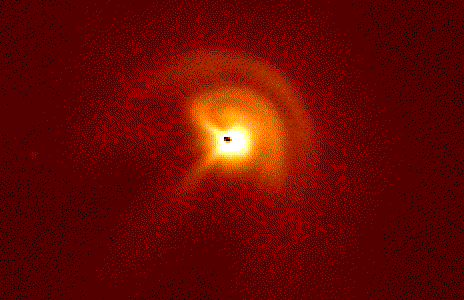Astronomy Picture of the Day
Discover the cosmos!
Each day a different image or photograph of our fascinating universe is
featured, along with a brief explanation written by a professional
astronomer.
April 14, 1996

The Rotating Jets of Comet Hyakutake
Credit:
James A DeYoung
(USNO),
USNO's 24-inch Telescope
Explanation:
Comet Hyakutake will reach its closest
point to the
Sun on May 1, passing well
inside the orbit of Mercury.
At this time, the comet's dust and
ion tail will be at their greatest physical
length. As the comet nears the
Sun,
gas and dust
are driven off the surface,
sometimes being shot off in jets. Although much of
this material ends up in the
tail, some interesting features can be seen
close to the comet's three kilometre
nucleus. Because the comet's
nucleus rotates, the jets can be seen to form arcs around the comet's
centre resembling a pinwheel. The above photograph, taken April 8, shows
two expanding arcs of cometary material and two source jets. The outermost
arc is at a projected distance of 12,000 kilometres from the nucleus. The
inner is about 8,000 kilometres from the nucleus. They are expanding from
the nucleus at 870 km per hour. The inner arc ends at the brightest of the
Comet Hyakutake's many jets.
Tomorrow's picture: NASA Mission to MAP the Universe
<
Archive
| Index
| Search
| Calendar
| Glossary
| Education
| About APOD
>
Authors & editors:
Robert Nemiroff
(MTU) &
Jerry
Bonnell (USRA)
NASA Technical Rep.:
Jay Norris.
Specific rights apply.
A service of:
LHEA
at
NASA/
GSFC
&:
Michigan Tech. U.
